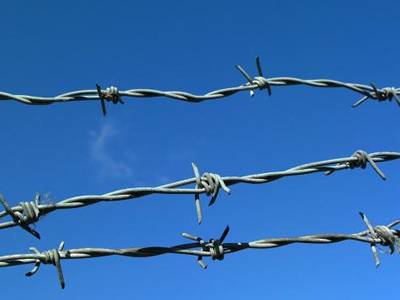Barbed Wire

Barbed wire, also known as barb wire (and frequently in dialect form spelled bob or bobbed), is a type of fencing wire constructed with sharp edges or points arranged at intervals along the strand(s). It is used to construct inexpensive fences and is used atop walls surrounding secured property. It is also a major feature of the fortifications in trench warfare (as a wire obstacle).
It is installed from the top down.
There are several ways to anchor the wire to a corner post:
- Hand-knotting. The wire is wrapped around the corner post and knotted by hand. This is the most common method to attaching wire to a corner post. A timber hitch works well as it stays better with wire than with rope.
- Crimp sleeves. The wire is wrapped around the corner post and bound to the incoming wire using metal sleeves which are crimped using lock cutters. This method should be avoided because while sleeves can work well on repairs in the middle of the fence where there is not enough wire for hand knotting, they tend to slip when under tension.
- Wire vise. The wire is passed through a hole drilled into the corner post and is anchored on the far side.
- Wire wrap. The wire is wrapped around the corner post and wrapped onto a special, gritted helical wire which also wraps around the incoming wire, with friction holding it in place.
| Wire Gauge | Size in MM | Length Per KG | Barb Distance | Barb Length |
|---|---|---|---|---|
| 12 X 12 | 2.50mm X 2.50mm | 6 Mtrs. | 75mm – 100mm (3″ – 4″) as per IS | 40mm – 50mm (1.5″ – 2″) as per IS |
| 12 X 14 | 2.50mm X 2.00mm | 8 Mtrs. | ||
| 14 X 14 | 2.00mm X 2.00mm | 12 Mtrs. |
